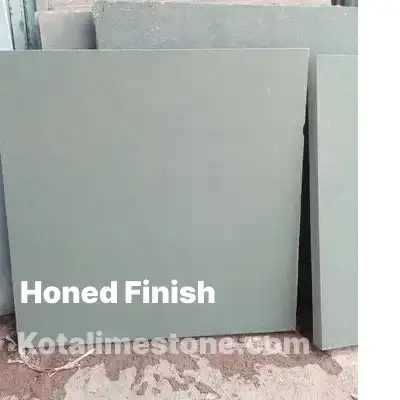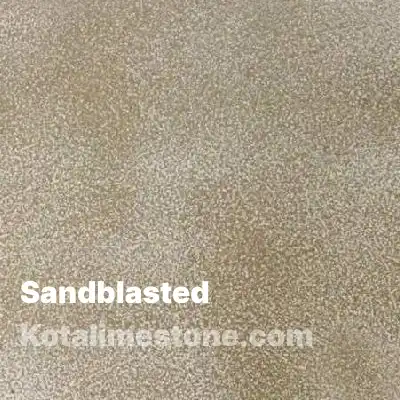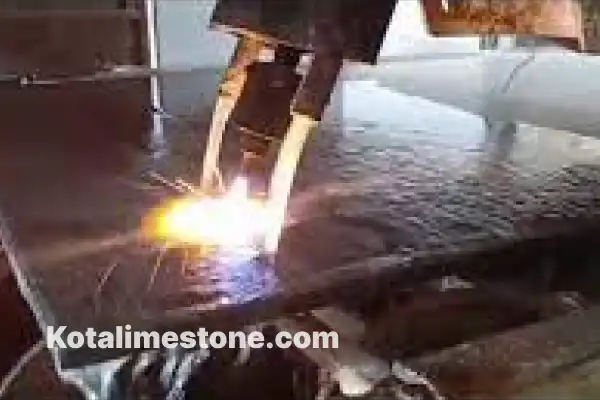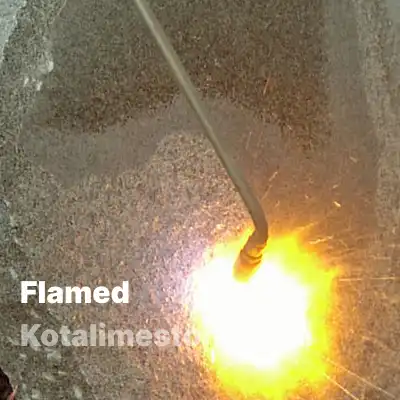
Kota Stone Finishes
Kota Stone Popular Finishes and Price
Kota stone available in Polished, Honed, Flamed, Brushed, Leather, River washed and Antique Finishes
Stone finishes refer to the various surface treatments applied to natural stones such as granite, marble, limestone, sandstone, and others to alter their appearance and texture. There are many types of stone finishes, each with its unique characteristics and advantages.
Each type of stone finish has its unique benefits and is suitable for different applications. For example, polished finishes are popular for countertops and floors, while flamed finishes are commonly used for outdoor surfaces due to their slip-resistant nature.
Some common types of stone finishes include:

Polished Kota Stone
Polished stone finish refers to a smooth, glossy surface treatment applied to natural stones, including kota stone, granite, marble, limestones and sandstone. This finish is achieved by grinding the stone surface with large machines and polishing it using specialized equipment and abrasive compounds.
The resulting surface is smooth, reflective, and pleasing to the touch, making it a popular choice for aesthetic surfaces such as countertops and floor tiles in both residential and commercial settings. Polished stone finishes are easy to clean and maintain, and they add a touch of opulence and elegance to any space.
However, it's important to note that not all stones are suitable for this finish, and some may require additional processing to achieve a high-quality shine. The type of equipment and abrasives used can also affect the final outcome.
Overall, polished finish on Kota Stone is highly desirable due to its durability, resistance to scratches and stains, and aesthetic appeal.

Honed Finish
A honed finish refers to a smooth but matte surface finish that has been obtained by grinding and polishing a stones or any other materials to a fine surface without reflecting light. This type of finish is often preferred for its modern, sleek appearance and its ability to resist showing fingerprints and other marks. In the case of stone, honing is typically done using abrasive grits that gradually remove material until the desired level of smoothness is achieved. Honing is commonly used to finish marble, granite, and other types of stone, but can also be applied to other materials such as stainless steel, aluminum, and brass.
In addition to its sleek appearance and durability, the honed finish also has practical benefits. The lack of shine makes it a good choice for flooring in high-traffic areas, as it is less slippery than a polished surface. It also provides a more tactile feel, making it a popular choice for countertops and other surfaces where tactile sensation is important.
One potential downside to the honed finish is that it may be more prone to staining than a polished surface, as it does not have the same degree of water resistance. However, regular sealing can help mitigate this issue.
Overall, the honed finish is a versatile and attractive option for a variety of applications. Whether used on stone, metal, or other materials, it offers a modern, understated look that is both functional and aesthetically pleasing.

Sandblasted Finish
A sandblasted finish is a surface treatment achieved by using compressed air to propel sand or other abrasive material onto a surface. This process creates a textured surface with a matte appearance, often described as a "roughened" or "weathered" effect. Sandblasting can be used on a variety of materials, including metals, plastics, and ceramics, but is most commonly used on natural stones like granite, marble, and limestone.
The sandblasting process involves spraying a stream of abrasive material onto the surface of the material being treated. The pressure and type of abrasive used can be adjusted to achieve different levels of roughness and depth of texture. In addition to sand, other common abrasives used in sandblasting include glass beads, aluminum oxide, and steel grit.
The sandblasted finish has a number of advantages. It provides a non-slip surface that is particularly useful for outdoor areas such as patios, walkways, and pool decks. It also hides scratches and other imperfections, making it a good choice for high-traffic areas. Additionally, sandblasting can be used to create decorative patterns or designs on a variety of surfaces.
There are also some potential downsides to the sandblasted finish. One is that it can be difficult to clean, as dirt and debris can become trapped in the textured surface. Another is that it may be more prone to staining than a smoother surface. However, regular cleaning and sealing can help mitigate these issues.
Overall, the sandblasted finish is a popular option for creating a unique and textured surface on a variety of materials. Whether used for functional or decorative purposes, it can add character and interest to any space.

Leather Finish
A leather finish is a type of surface treatment applied to natural stone that results in a unique texture and appearance. This finish is achieved by grinding and brushing the surface of the stone with diamond abrasive pads until a smooth, matte surface is created. The resulting surface has a soft, leather-like texture that is velvety to the touch.
The leather finish is particularly popular for its rustic and natural appearance, which makes it a great option for adding warmth and character to any space. It is often used in interior design for feature walls, floors, and countertops, as well as in outdoor applications such as garden paths and pool decks.
One of the key advantages of the leather finish is its ability to hide scratches and other imperfections, making it a good choice for high-traffic areas. It is also less prone to staining than some other finishes, as the matte surface does not reflect light in the same way that a polished surface does. However, it is still important to clean up spills promptly and to seal the stone periodically to maintain its appearance and protect against staining.
To achieve the leather finish, the stone is typically honed to a smooth surface using diamond abrasive pads, and then brushed with specialized tools to create the desired texture. The level of brushing can be adjusted to achieve different levels of texture and depth.
In addition to its unique appearance and durability, the leather finish is also relatively low-maintenance compared to some other stone finishes. It does not require the frequent cleaning and polishing that a high-gloss finish does, making it a great choice for busy households or commercial spaces.

River Washed Finish
A river washed finish is a surface treatment applied to natural stone that creates a distinctive, weathered appearance. This finish is achieved by tumbling the stone in a drum with water and small stones or pebbles, which creates a smooth, slightly worn surface with a matte finish. The resulting appearance is reminiscent of stones that have been smoothed by the motion of water in a river or stream.
The river washed finish is often used for outdoor applications such as patios, pool decks, and garden paths, as well as for feature walls and other interior design elements. It is particularly popular for creating a natural, organic look that blends seamlessly with outdoor surroundings.
One of the advantages of the river washed finish is its slip-resistant surface, which makes it a great choice for outdoor areas that may become wet or slippery. It is also relatively low-maintenance, as the matte surface does not show dirt or stains as readily as a polished surface does. However, it is still important to clean up spills promptly and to seal the stone periodically to protect against staining.
To achieve the river washed finish, the stone is tumbled in a rotating drum with water and small stones or pebbles for several hours or even days, depending on the desired level of texture and weathering. The result is a surface that is smooth to the touch but has a slightly rough appearance.
In addition to its unique appearance and durability, the river washed finish is also eco-friendly, as it uses natural materials and does not require the use of chemicals or other harmful substances. This makes it a great choice for those who are concerned about sustainability and environmental impact.

Flamed Finish
A flamed finish is a surface treatment applied to natural stone that results in a highly textured, non-slip surface with a unique appearance. This finish is achieved by exposing the surface of the stone to intense heat, causing the crystals in the stone to burst and creating a rough, pitted surface.
The flamed finish is particularly popular for outdoor applications such as pool decks, patios, and walkways, as it provides excellent slip resistance even when wet. It is also used for feature walls and other interior design elements, where it adds a rugged, natural look and feel.
One of the advantages of the flamed finish is its durability, as the pitted surface is highly resistant to scratches and other types of wear and tear. It is also relatively low-maintenance, as the textured surface does not show dirt or stains as readily as a smooth surface does. However, it is still important to clean up spills promptly and to seal the stone periodically to protect against staining.
To achieve the flamed finish, the stone is first heated to a high temperature using a gas flame or other heat source. The surface is then quickly cooled with water, causing the crystals in the stone to burst and creating the characteristic pitted surface. The level of heat and the length of time that the stone is exposed to the heat can be adjusted to achieve different levels of texture and depth.
In addition to its unique appearance and durability, the flamed finish is also eco-friendly, as it does not require the use of chemicals or other harmful substances. This makes it a great choice for those who are concerned about sustainability and environmental impact.

Antique Finish / Reclaimed Stone Finish
An antique finish is a type of surface treatment applied to natural stone that creates a weathered, aged appearance. This finish is achieved by using various techniques to create a surface that appears to be worn and patinaed, as though it has been in use for many years.
The antique finish is often used in interior design for feature walls, floors, and countertops, as well as in outdoor applications such as garden paths and pool decks. It is particularly popular for creating a warm, inviting atmosphere and adding character and charm to a space.
One of the key advantages of the antique finish is its ability to hide scratches and other imperfections, making it a good choice for high-traffic areas. It is also less prone to staining than some other finishes, as the matte surface does not reflect light in the same way that a polished surface does. However, it is still important to clean up spills promptly and to seal the stone periodically to maintain its appearance and protect against staining.
To achieve the antique finish, the stone is typically treated with various techniques such as sandblasting, brushing, and chiseling to create a worn, textured surface. A patina or other coloring agent may be applied to further enhance the antique appearance. The level of texture and depth can be adjusted to achieve different levels of antiquing and character.
In addition to its unique appearance and durability, the antique finish is also relatively low-maintenance compared to some other stone finishes. It does not require the frequent cleaning and polishing that a high-gloss finish does, making it a great choice for busy households or commercial spaces. The antique finish can also be easily restored and refreshed as needed, without having to replace the entire surface.








